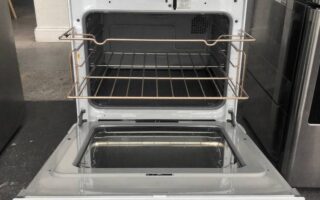The kitchen is often considered the heart of the home, a place where meals are prepared and families gather. Kitchen safety for children is a crucial concern, as this area of the house is filled with potential hazards. The kitchen can pose significant risks to curious little ones, from sharp knives to hot stoves.
Creating a child-proof kitchen is not just about installing safety gadgets but also an essential step in ensuring the safety of your children. Understanding the risks, designing a safe environment, educating your child, and maintaining vigilant supervision can significantly reduce the chances of kitchen-related accidents. Implement these safety measures and keep all children safe in the kitchen.
This involves a combination of strategic design, education, and supervision. Now you can explore the various aspects of keeping your child safe in the kitchen with us focusing on practical solutions and educational approaches.
Understanding the Risks

Common Kitchen Hazards for Children
The kitchen is a treasure trove of fascinating objects for children, but many of these items can be dangerous. Let’s break down some of the most common hazards:
- Sharp Objects: Knives, scissors, and other cutting tools are essential in the kitchen but can cause serious injuries if mishandled by children.
- Hot Surfaces: Stoves, ovens, and even hot pots can lead to burns. Children may not understand the concept of heat and its dangers.
- Toxic Substances: Cleaning products and certain food items can be toxic if ingested. It’s crucial to keep these out of reach.
Statistics on Kitchen-Related Accidents Involving Children
Statistics reveal the gravity of kitchen-related accidents. According to various studies, a significant percentage of household accidents involving children occur in the kitchen. These incidents range from minor cuts to severe burns and poisoning. Understanding these statistics can help parents recognize the importance of vigilance and preventive measures.
Psychological Aspects: Why Children Are Drawn to the Kitchen
Children are naturally curious and often drawn to the kitchen because it’s a hub of activity. The sights, sounds, and smells are enticing, and they often want to mimic adult behaviors. Understanding this curiosity can help parents devise strategies to keep children safe while satisfying their inquisitive nature.
Designing a Child Proof Kitchen

Layout and Accessibility
The layout of your kitchen plays a significant role in preventing access to dangerous areas. Here are some strategies to consider:
- Barriers: Installing gates or keeping doors closed can physically prevent children from entering the kitchen unsupervised.
- Strategic Design: Arrange the kitchen so that hazardous items are stored in less accessible areas. For example, place knives and cleaning products in high cabinets.
Child Proofing Techniques
Creating a child-proof kitchen involves more than just moving items out of reach. Here are some techniques to enhance safety:
- Child Locks: Install locks on cabinets and drawers to prevent children from accessing dangerous items.
- Safety Latches: Use latches on appliances like ovens and refrigerators to keep them securely closed.
- Child-Safe Materials: Opt for appliances and materials that are designed with safety in mind, such as rounded edges and non-slip surfaces.
Safe Storage Solutions
Proper storage is key to a child-proof kitchen. Consider these solutions:
- Out of Reach: Store hazardous items like knives and cleaning products in high cabinets.
- Clear Containers: Use transparent containers for safe items, allowing children to see what’s inside without opening them.
- Designated Safe Area: Create a specific area in the kitchen where children can safely play or help with cooking tasks.
| Hazardous Item | Recommended Storage Solution |
|---|---|
| Knives | High cabinets with locks |
| Cleaning Products | Locked under-sink cabinets |
| Hot Appliances | Out of reach or with barriers |
Educating Your Child

Teaching Kitchen Safety
Education is a powerful tool in preventing accidents. Here are some ways to teach your child about kitchen safety:
- Age-Appropriate Lessons: Tailor safety lessons to your child’s age and understanding. For younger children, simple rules like “don’t touch the stove” can be effective.
- Role-Playing Scenarios: Use role-playing to simulate kitchen situations and teach children how to respond safely.
Encouraging Safe Behavior
Encouraging safe behavior involves more than just rules; it requires positive reinforcement and clear expectations:
- Positive Reinforcement: Praise and reward your child when they follow safety rules.
- Clear Boundaries: Set and consistently enforce boundaries regarding kitchen access and behavior.
Monitoring and Supervision
Importance of Adult Supervision in the Kitchen
No amount of child-proofing can replace the importance of adult supervision. Always keep an eye on your child when they are in or near the kitchen.
Tips for Maintaining Vigilance While Cooking
- Stay Focused: Avoid distractions like phones or TV when cooking with children around.
- Involve Your Child: Give them safe tasks to keep them engaged and within your sight.
Using Technology for Added Safety
Technology can be a helpful ally in maintaining kitchen safety:
- Cameras: Install cameras to monitor the kitchen area.
- Alarms: Use alarms on doors or cabinets to alert you if they are opened.
Alternatives to Kitchen Access

Creating a Play Area Away from the Kitchen
Designate a play area outside the kitchen where children can safely engage in activities while you cook.
Engaging Children in Safe Cooking Activities
Involve your child in cooking by giving them safe, age-appropriate tasks. This can satisfy their curiosity and teach them valuable skills.
Offering Cooking Classes Designed for Children
Consider enrolling your child in cooking classes designed for their age group. These classes teach kitchen safety and basic cooking skills in a controlled environment.




